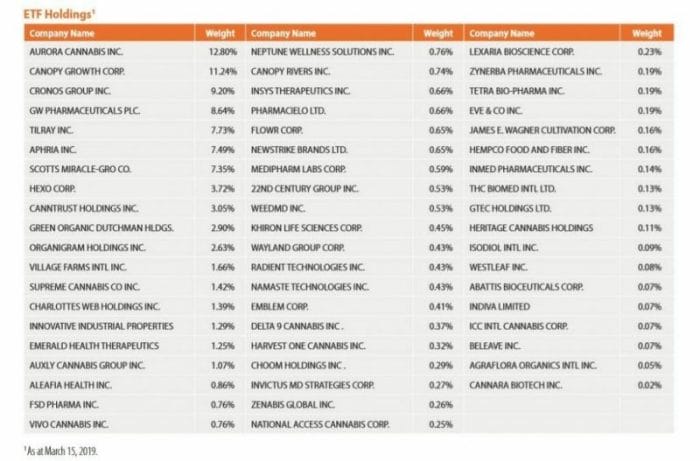Your weed bet is (probably) down, and no, this isn’t a repost.
If you’re a diversified investor, you’re laughing. The S&P/TSX Composite Index is up a tad since January and gold is at a multi-year high.
But cannabis, the sector with its own section in the biggest national newspapers, is down with a capital D. The Horizons Marijuana Life Sciences Index (HMMJ.T) is down 23% since March and the ETFMG Alternative Harvest (MJ.NYSE) is down 11.3% since its peak three months ago.
So what’s the deal? Why isn’t the supposedly red-hot cannabis sector benefitting like the rest of the market? In other words, ‘why is my weed bet down?’
For starters, the algorithms which decide the stocks that make up baskets like Horizons don’t do due diligence. They just sort companies by market cap and present a ‘balanced’ assortment of companies on a value scale.
Here is the list of weed companies that make up the HMMJ basket.

Some of these companies are duds, but some are thoroughbreds. We wrote about Village Farms (VFF.T) back in December 2018 before the company’s incredible run from $6 to more than $23, and we similarly covered Khiron Life Sciences (KHRN.T) before it nearly tripled in April.
Both companies jumped on Latin America early and were rewarded for their foresight.
Sure, you’ve got the major players in there too, naturally. Aurora Cannabis (ACB.T) and Canopy Growth (WEED.T) are both featured as a counterbalance to some of the riskier plays, though these companies are both trading 54 times sales and 68 times sales themselves, respectively.
And then you’ve got the duds, the downers. In May, we covered one of the most egregious examples of this we had ever seen by a single entity. Spoiler alert: unless substantiated by photographic evidence, it’s entirely possible the assets flaunted on oh-so-professional press releases by your favourite weed company may not even exist.
So generally, your weed bet is probably down, at least, if you aren’t studying the market.
So why is this happening? It’s not an easy thing to answer, but there are a few through lines and trends to be aware of in case the company you’re invested in goes the same way.
Growth through M&A
Done correctly, mergers and acquisitions (M&A) can be an effective strategy for growth. Instead of devoting time, energy and capital to researching IP or, say, building connections from the ground up, acquiring a smaller outfit which has already done the work can seem like an attractive alternative.
There are two drawbacks to this strategy, the main one being capital. The $5B Constellation Brands (STZ.NYSE)put down on Canopy has been key in this respect. Even if Canopy doesn’t need a particular piece of IP, buying a company out keeps competitors at bay and takes said IP out of the game.
When Facebook (FB.Q) bought Instagram, it was a calculated move to consolidate different age demographics under one umbrella. Instead of buying every social media platform they could find, Facebook did its research and picked the perfect one.
The same can be said for Disney’s (DIS.NYSE) acquisition of Pixar. The two companies had always enjoyed a close working relationship, and Pixar stood to benefit from Disney’s extraordinary cash position. Disney wanted the best and they got it.
Pinpoint precision. That’s how you do it.
Unfortunately, in cannabis, this isn’t the case.
Going back to Khiron, the company recently closed its acquisition of an Uruguayan cannabis company, granting access to the southern Brazilian market. We think that’s a case of M&A done right.
Industry leader and curve-setter, Canopy Growth, on the other hand has adopted more akin to an ocean trawler. Down the hatch.

The company continues to view M&A as a priority, having “invested CAD380 million in acquisitions in fiscal 2019.”
These acquisitions included AgriNextUSA, Spectrum Cannabis Colombia S.A.S. and Storz & Bickel.
Interestingly enough, Canopy listed another kind of “investment” as well:
In G&A, our investments increased from CAD44 million to CAD168 million, as we’ve built out our global team. Our back office functions, including finance, technology, human resources, and legal.
–Bruce Linton, CEO of Canopy Growth
Given that Canopy spent in the neighbourhood of 66% of it’s Q1 revenues on G&A in 2019, I wonder what kind of ROI Canopy can expect there.
Canopy’s shopping-spree is made possible because of Constellation’s $5B investment. To see what happens when a company-turned-spendthrift attempts to pull a Canopy without a financial backer, look no further than Aurora Cannabis.
In 2018, the company made three acquisitions of note:
Aurora “issued approximately 69.3 million common shares and paid approximately $134 million” for CanniMed, acquired Whistler MMJ “in an all-share transaction valued at up to approximately $175 million and acquired MedReleaf “in an all-share transaction valued at approximately C$3.2 billion on a fully diluted basis.”
With over 1B common shares in circulation, nearly triple Canopy’s share count, Aurora bagholders are footing the bill.
And for what? The company didn’t even know what it was buying when it came to Anandia Laboratories. Here’s the official statement on the transaction:
Management is in the process of gathering the relevant information that existed at the acquisition date to determine the fair value of the net identifiable assets acquired and liabilities assumed. As such, the initial purchase price was provisionally allocated based on the Company’s estimated fair value of the identifiable assets acquired and the liabilities assumed on the acquisition date. The values assigned are, therefore, preliminary and subject to change. Management continues to refine and finalize its purchase price allocation for the fair value of identifiable intangible assets, property plant and equipment, and goodwill.
Not encouraging.
Show your work
Aurora grew revenues from $12M in Q1 2018 to just $72M in Q1 2019 while spending billions in shares on just those three acquisitions alone. (Shareholder equity, burned through it). The company’s P/E ratio is -76.4 to-date and its liabilities exceed $1B. ‘Nuff said.
This kind of irresponsibility is rampant in the cannabis sector. The fact that both Wayland Group and Namaste (N.V) are in a prominent cannabis ETF alongside Khiron and Village Farms is both ludicrous and unsurprising–differentiating different weedplays is difficult even for those who do it for a living.
Sadly, countless investors regularly sound off in Facebook investor groups asking the same question posed at the beginning of this article.
Though pumping stocks is typically prohibited in the groups’ ruleset, kindly ‘good-samaritans’ will invariably chime in about companies they ‘have no stake in’ but ‘admire from a distance.’ If my ironic cynicism is not immediately apparent, consider it a limitation of the medium.
The truth is the companies I see routinely foisted on unknowing rookie investors are crap. They’re trash, folks! No good. In the words of our beautiful orange President, they’re not sending their best.
But there are outliers, companies that haven’t burned through shareholder equity and don’t have increasing losses per share.

Let’s compare Canopy and Aurora to a smaller, more responsible company. For our purposes, we’ll use a client, Supreme Cannabis (FIRE.T) as an example of what to look out for when making an investment in the weed space.
Supreme had a loss-per-share (LPS) of $0.05 for the nine months ending March 31, 2019. The company is pretty close to making money. In contrast, Canopy had a LPS of $2.57 for the year ending March 31, 2019. It’s not a perfect comparison, but the dollar figure is astounding.
Don’t even get me started on Aurora. The company only had a $0.31 LPS for the nine months ending March 31, 2019, but the numbers don’t seem to add up.
On Aurora’s most recent financial statements, the company added $2.41B of goodwill to its asset line from acquisitions during the preceding nine months. Because goodwill is an asset, it decreases LPS, but because it’s intangible and not easy to quantify, it can be used to inflate value.
Supreme has a three-to-one quick ratio, meaning it has more than enough assets to cover its liabilities. Canopy’s quick ratio is 5.6 and Aurora’s is 4.7. The difference? Supreme’s goodwill is only 0.002% of its total assets. The other two can’t say the same (psst, Canopy’s is nearly 20%).
So do your homework. Whip out those calculators and do some analysis of your own. If a company you’re invested in doesn’t pass the acid test, or the smell test, think twice about going long. If you don’t make a decision about your financial future, it’ll get made for you.
–Ethan Reyes
Full disclosure: Supreme Cannabis and Khiron Life Sciences are Equity.guru marketing clients.
Correction: The story previously stated the following quote was attributable to the acquisition of Whistler MMJ instead of Anandia Laboratories.
“Management is in the process of gathering the relevant information that existed at the acquisition date to determine the fair value of the net identifiable assets acquired and liabilities assumed. As such, the initial purchase price was provisionally allocated based on the Company’s estimated fair value of the identifiable assets acquired and the liabilities assumed on the acquisition date. The values assigned are, therefore, preliminary and subject to change. Management continues to refine and finalize its purchase price allocation for the fair value of identifiable intangible assets and the allocation of goodwill.”

